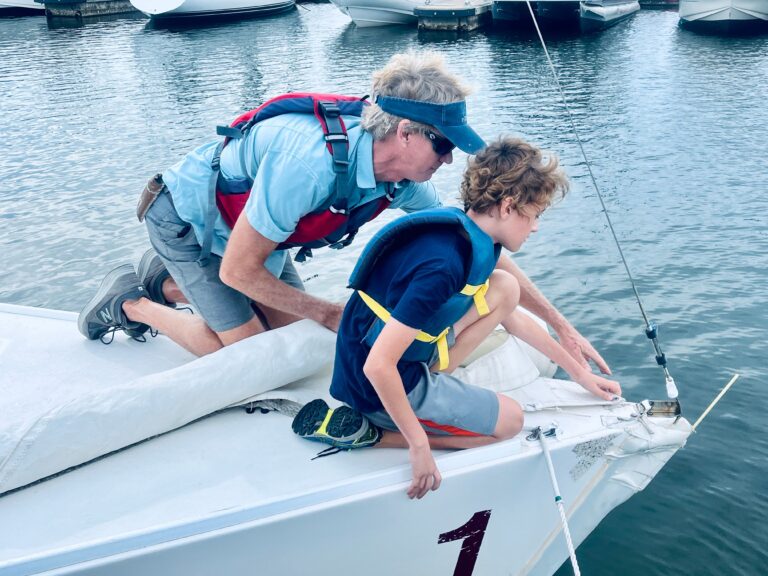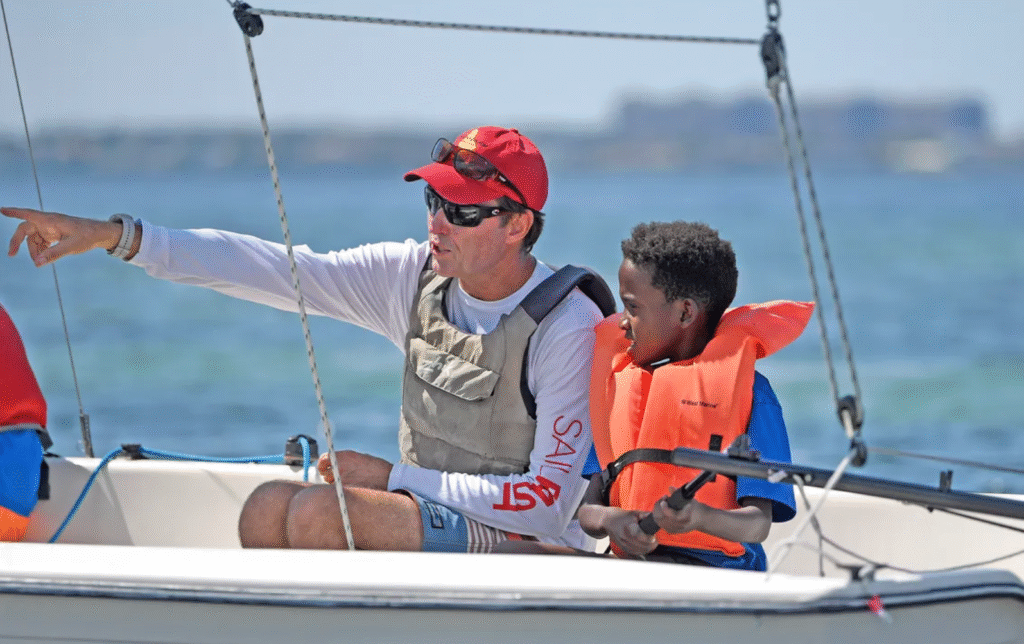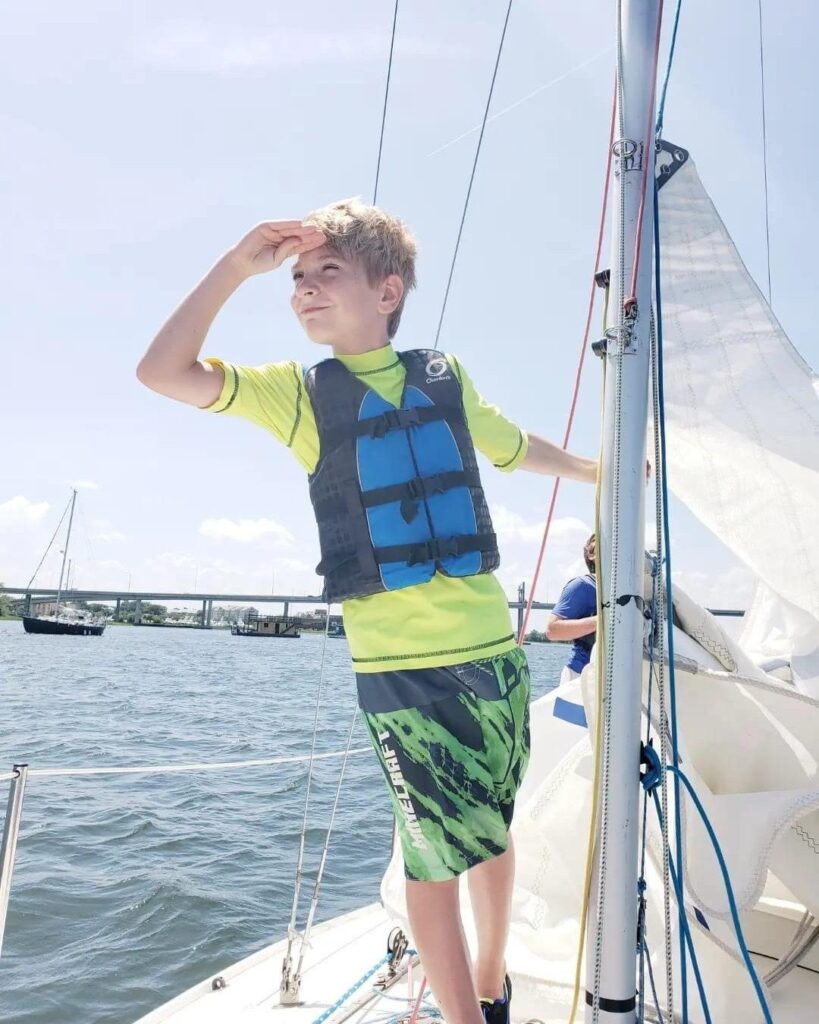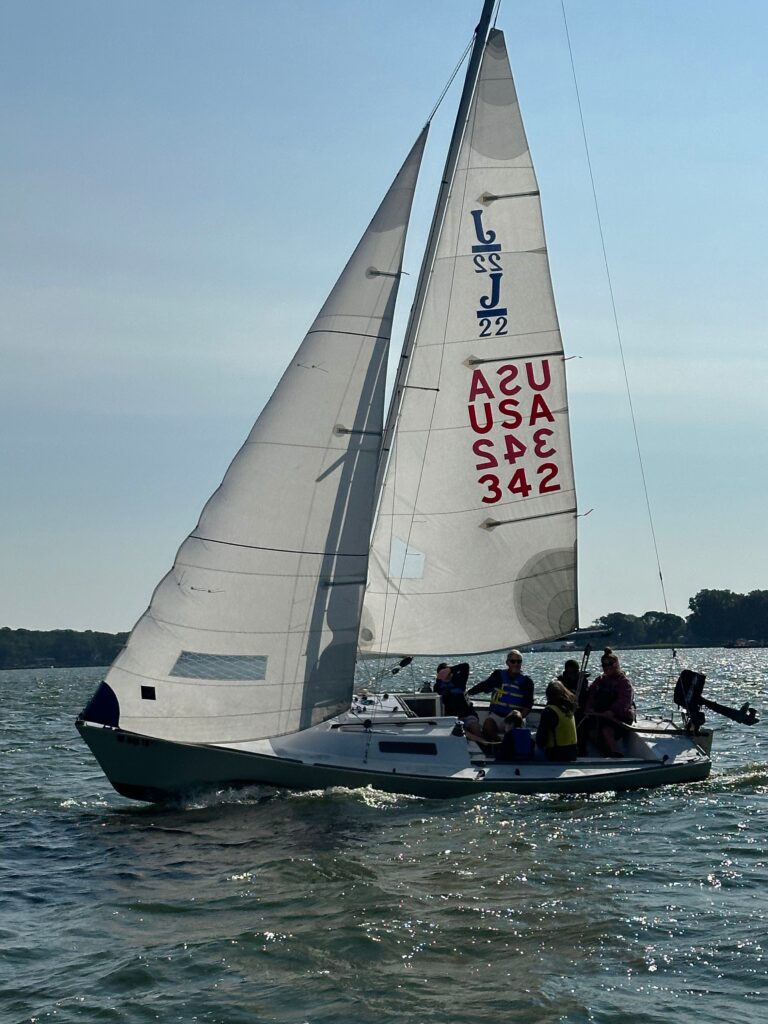Zig Sailing Insiders – Exclusive Interview with Spectrum Sailing Founder, Scott Herman
A couple of weeks ago, I was in Houston, TX, conducting a presentation that Zig Travel was hosting at the Lakewood Yacht Club. After we wrapped up, we were speaking with some of the club members who proudly shared that they were hosting a special event and encouraged me to check it out.
That event turned out to be a Spectrum Sailing camp — a program I had not heard of before, but one that quickly got my attention. After speaking with a few instructors and families, I discovered that Spectrum Sailing is an amazing organization that provides sailing experiences for Autistic youth across the country. Their mission and impact on the kids and families caught my attention.
I wanted to learn more. So, I reached out to the founder, Scott Herman, for a deeper look into how Spectrum Sailing began and the incredible work they are doing.
Make sure you read the exclusive interview in the Zig Sailing Insider’s May 2025 blog for a one-on-one conversation and discover the inspiring story behind Spectrum Sailing.
Article by Ty Christopher Olsen, April 18, 2025.

SPECTRUM SAILING: EMPOWERING YOUNG SAILORS THROUGH INCLUSION
TCO: Scott, tell us about your background with sailing and why a program like Spectrum Sailing is important to you.
SH: I started sailing in college. My first step onto a sailboat was a Tartan 10 on Lake Erie, arguably the most Midwestern boat you can find. I never sailed small boats or went to sailing camp as a kid. I wasn’t involved in youth racing programs or on college sailing teams. I simply jumped into keelboats and never looked back.
Once I caught the sailing bug, I dove into big boat racing and stuck with it. Life took me from Florida to Chicago, where I raced in the Chicago-Mac, and eventually back to Charleston — my second time living here. Each move came with more sailing, and my love for the sport only grew.
About eight years ago, after we moved back to Charleston, I wanted to share sailing with my two kids. My son Daniel, now 17, is Autistic. As I looked into sailing camps, I quickly realized that none of the local programs could accommodate him. Every organization I contacted, all five in the area, turned us down. They didn’t have the resources, training, or staff needed to support Autistic kids.
I had never been to a sailing camp as a kid, and I wanted Daniel to have that experience, the chance to be on the water, to be part of a group, to build confidence. After a year of trying to find a program and getting nowhere, my wife and I decided to create our own.
We partnered with a local organization and launched a camp designed specifically for Autistic kids. We thought maybe we’d get a few families, but we had over 70 applicants for 10 spots. That was the moment I realized this wasn’t just about my son anymore. There was a real need.
From day one, our camps have been 100% free to the families. We modeled our structure after a California nonprofit called Surfers Healing, which provides surf experiences for Autistic kids, sometimes hosting over 100 kids in a single day. That became my benchmark: to remove the financial barrier and include as many families as we could.
We started in Charleston, but the sailing community is tight-knit, and word spread. The Chicago Corinthian Yacht Club reached out after hearing what we were doing and asked us to bring a camp there. That session became the foundation for our traveling program.
It was clear that if we wanted to grow, we needed infrastructure — a 501(c)(3), insurance, a website, branding, etc. What began as a local idea for my son quickly became something much bigger.
Since we launched our national program in 2021, the growth has been incredible. That first year, I was crashing on couches just to make it work while traveling to various camps. But we kept expanding. In our first year we went from just one camp at locations in Sarasota, Chicago and Charleston to eight camps in just one year! Then we were quick to add Park City, New Orleans, and several Midwest stops. In our second year, 160 kids sailed with us. In 2024, we hosted over 200 kids from Southern California to Maine. In 2025, we’re planning 12 camps and expect to reach over 250 kids, with a strong presence in Florida, the Midwest, and the East Coast.
MORE THAN SAILING - WHERE SAFETY MEETS POSSIBILITY
But the heart of Spectrum Sailing goes beyond the sport. We emphasize water safety because drowning is the leading cause of death among Autistic individuals. That reality drives our mission. We created an online training module — designed entirely by Autistic adults through a partnership with AspiraTech in Chicago — to teach everything from Autism fundamentals to our day-to-day camp operations, with a strong focus on safety. There’s nothing else like it out there, and I’m proud that our program is setting the standard.
We’ve also partnered with George Washington University. A doctoral student in Occupational Therapy has spent the past 18 months working with us and is now publishing her dissertation on the social and emotional benefits of inclusive sailing. Her research gives us real data to support what we already knew: these camps change lives.
Looking back, it’s humbling to see how far we’ve come. What started as a way to give my son something I never had has turned into one of the most impactful inclusive sailing initiatives in the country. We’re not just teaching kids how to sail — we’re creating opportunities, building confidence, and fostering community for families of Autistic children.

TCO: Scott, can you give a brief explanation of what the spectrum is regarding Autism?
One of the most helpful analogies I’ve heard to understand Autism is comparing it to the difference between a PC and a Mac. Both are fully functioning systems — they just operate differently. Similarly, Autistic individuals process the world in a unique way. It’s not wrong or broken, it’s simply different.
That’s why Autism is referred to as a spectrum — because every individual presents differently. At our camps, we see this wide range firsthand. Some campers are non-verbal and require physical assistance getting in and out of the boats. Others are independently sailing by the second day, trimming to the telltales and mastering the basics.
One memorable example was a girl in Charleston. On the third day of camp, after her first real experience on the water, she told us she wanted to become a sailing instructor. Since then, we’ve helped her earn a scholarship to a middle school sailing program, and she’s now on track to be a junior instructor this summer.
With such diversity in our campers, our goal is to create a fully inclusive environment — one that allows each child to be themselves, feel supported, and find their own version of success. That success looks different for every participant. For some, it might be simply showing up, listening in the classroom sessions, and joining me on the safety boat. For others, it’s confidently sailing by the end of camp.
We don’t define success by a single standard. Instead, we meet each child where they are, support them on their journey, and celebrate every step forward. That individualized approach is at the core of everything we do.
TCO: You mention “kids”, is there an age limit to the participants?
SH: Right now, our programs are designed for youth ages 10 to 17, but we’re already dreaming bigger. We are actively exploring ways to expand into adult programming, which we know would be a game-changer for many families. Of course, to make that happen, we’ll need additional funding and staffing support — but it’s on our radar and something we’re committed to building.
The demand speaks for itself. In Chicago, we had 80 kids apply for just 20 spots. In California, it was 122 applicants for the same number of openings. The interest is overwhelming — and incredibly motivating.
That’s why one of my biggest priorities right now is increasing access and inclusivity. We want every child, and eventually every person, who wants to sail with us to have that opportunity, regardless of their diagnosis or background.

TCO: How do these kids and families find out about the camps and when they will be happening?
SH: The truth is, for 99% of the kids who attend our camps, it’s their very first time doing any of it — stepping onto a dock, wearing a lifejacket, or even being on a boat. That’s what makes the experience so powerful. It’s not just about sailing; it’s about opening a brand-new world to them.
When we secure a new location for a camp, our first step is outreach. We connect with local Autism service providers, schools, and communities, and spread the word through social media. What’s amazing is how quickly the momentum builds. Autism communities, much like the sailing community, are incredibly tight knit. Once we make that initial connection, the word spreads like wildfire.
I think what makes families feel especially connected to our mission is knowing that I’m not just running the camp, I’m also the parent of an Autistic child. That shared experience creates an immediate sense of trust and understanding. Parents know their kids are being welcomed into an environment created by someone who truly gets it — someone who’s walked that path with their own child.
TCO: How do you find staff and instructors for each of the camps? Are they experienced with working with Autistic kids?
SH: Here’s how it all comes together: when we bring a camp to a new location, we ask the host yacht club for a few key things to make it happen. Since I can’t exactly tow three keelboats across the country, we rely on the Clubs to provide three sailboats, a coach boat, a classroom space, and, most importantly, three capable instructors who are ready to work with our kids.
But that’s just the start. What makes this program truly special is the unique team we build on each boat. Alongside the sailing instructors, we place trained support volunteers from the Autism community. People like occupational therapists, physical therapists, special education teachers, and even pediatric doctors. These professionals provide an extra layer of support, helping to create a safe, responsive, and empowering experience for every participant.
While we have a small roster of volunteers we can call on if needed, we’ve found that most Clubs are not only willing, but excited to rally their own instructors and local experts to help. It becomes a community effort and that energy, that shared sense of purpose, is what makes every camp feel so impactful.
"Of course, I absolutely want these kids to enjoy sailing, and many do, but the more camps we run, the more I realize the real impact happens off the water. Sailing is just the vessel."
TCO: Walk us through what a typical 3-day camp consists of for the kids. What skills do you teach the kids?
SH: In the long run, it’s not just about sailing — it’s about experiencing something new. The friendships made and the confidence built during these camps often carry far beyond the water. I’ve lost count of the times a parent has reached out to tell me their child went home and, for the first time ever, rode a bike. Or how, months later, when their child was hesitant to try something new, they reminded them of sailing camp, “Remember how brave you were out there?” That kind of emotional leverage is powerful.
Of course, I absolutely want these kids to enjoy sailing, and many do, but the more camps we run, the more I realize the real impact happens off the water. Sailing is just the vessel.
As for how the camp actually works, think of it like a Green Fleet Opti camp. We kick off each day with a “knot of the day” — starting simple and building from there. Some kids become knot-tying ninjas, while others give it one shot and proudly move on. Then comes our chalk talk, complete with a cheesy “dad joke of the day” to get the laughs rolling and help ease everyone into the day. Socialization is a big part of this experience, we make space for each child to share a little about themselves, creating a safe and welcoming environment.
We dive into weather discussions and the different parts of the boat — especially the keel. We focus on the keel early because it helps reassure the kids that the boat is stable and safe, that’s a huge confidence booster. By Day 2, we’re talking about points of sail and “no-go zones.” On Day 3, we dig into the fun stuff — how to actually make the boat go where you want it: tacking, gybing, steering.
Before we head out on the water, we follow the big four rules: lifejackets, water bottles, bathroom break, and sunscreen. Harken Derm Sunscreen has been an amazing partner, supplying every camp with plenty of sunscreen and UV-protective long-sleeve shirts. It’s not just about sun safety; it’s part of teaching the kids how to take care of themselves while adventuring outdoors.
Then we break into groups. Each instructor gets a set of flashcards with “fun facts” about their campers, what they love, what makes them tick, and any important sensitivities or challenges. With this knowledge, we head to the docks, hop on the boats, and put all the classroom learning into action. Every camper gets a chance to steer, handle the sails, and discover how the different parts of the boat actually work.
After each on-the-water session, we debrief with the kids and parents, give our instructors a short break and then do it all again with a brand-new group of 10 campers. We run two sessions a day, and while it’s a lot of work, the energy and joy from these kids make it feel like the most rewarding job in the world.
TCO: What is some of the feedback that you get from the kids or families once they have completed a camp?
SH: The feedback we receive from these camps is nothing short of incredible. It’s the kind of feedback that stops you in your tracks and reminds you exactly why this matters.
After our camp in Houston, one mother approached an instructor with tears in her eyes. She told us that her daughter, who had never been able to initiate a conversation in her life, had introduced herself to another girl on the boat. Not only that, but she also wanted to get to know her. Her mom stood there in disbelief, saying they had tried everything to help their daughter open up, therapy, social groups, countless interventions, but for the first time, on that boat, her daughter did it completely on her own.
Then there was a teenage girl in Michigan this past August. It was the end of summer, she arrived guarded and clearly didn’t want to be there. But something shifted. She ended up connecting with a younger camper, helping him with his lifejacket, applying sunscreen, gently taking him under her

wing. They spent the afternoon sailing side-by-side like siblings. Her mother told us later that this camp was the only time her daughter had been outside all summer.
We’ve had a boy walk barefoot on grass for the first time. A camper who went home and rode her bike down the street, something her parents had tried to encourage for years. These seemingly small victories are monumental. When you give a child the confidence to sail a boat, something they never imagined they could do, you give them the confidence to try anything.
But the real magic of these camps goes beyond sailing. This is about opening doors. About saying “yes, you belong here” in a world that too often says “no.” And it’s not just the kids who feel that. As a parent of an Autistic child myself, I know firsthand how isolating it can be. You don’t always get to sit in the bleachers for soccer games or stand in line for birthday cake. You’re not always part of the school pick-up chatter. But here, while the kids are in the classroom or out sailing, parents gather too. They connect they trade tips. “Where do you get your child’s haircut?” “What dentist do you use?” These are simple questions, but they hold so much weight when you’ve felt alone in the journey.
One of our board members, Bill Faude from Harken Sailing, said it best. When he first got involved, he thought we were just giving boat rides. Then he saw it with his own eyes — the kids were really learning to sail. And what struck him even more? The profound impact on the families. One comment Bill said, that is so true, “Most sailing kids have a drawer full of sailing shirts. These kids have one. And it’s from our camp.”
At a recent National Autism Summit, I gave a virtual presentation. The host’s son had attended one of our camps two years earlier. When the session started, he appeared on screen wearing his Spectrum Sailing shirt. I smiled and assumed he’d put it on just for the occasion. Apparently, her son wears a different color each day, and his mother told me. “He wears it every week, it’s his favorite for blue-shirt days.” For two years, he’s been wearing the same Spectrum Sailing shirt.
This is more than sailing. This is what happens when the sailing community gives back. Sailing is something we sometimes take for granted, but for these kids it an entirely new opportunity.
TCO: Speaking of partnerships, do you have other partners that work with you besides Harken?
SH: Absolutely. We’re proud to have strong support from both the sailing community and corporate partners. Within the sailing industry, our sponsors include Harken and Harken Derm, Vakaros, The Yacht Rigger, Sail22, MarkSetBot, and American Magic, who has generously contributed as well.
On the corporate side, one of our largest donors has been a major Midwestern grocery store chain. Additionally, we’ve received significant backing from national philanthropic organizations, including the TK Foundation and NEXT for AUTISM — the latter awarding us our largest grant to date.
TCO: What does the future for Spectrum Sailing look like? Where are you hoping to take the program?
SH: We have big dreams for the future, and while we’re careful to grow at a sustainable pace, the possibilities are exciting.
Right now, our 3-day camp model works beautifully. It’s the perfect balance for our sailors, many of whom are worn out (in the best way!) after just a half-day on the water. It also allows us to travel and reach more communities. That said, we’re exploring the idea of expanding to a 4-day format in the future. To make that possible, we’d likely need dedicated instructors based on both the West and East Coasts to support a broader schedule.
One of the most meaningful opportunities we see is developing a Level 2 program for sailors who have thrived in our camps and want to keep progressing. So many of our participants show tremendous passion and talent, and it’s tough to say goodbye knowing there aren’t always options for them to continue. We hope our host clubs will consider integrating our sailors into their regular programming and we’re ready to support that transition however we can.
We’re also incredibly excited about the idea of launching an adult sailing program, giving even more individuals on the spectrum a chance to experience the joy and empowerment of sailing. In the long term, we envision host clubs taking our proven model and running similar programs with our guidance, essentially creating a “Spectrum Sailing franchise” where our mission continues on in communities across the country, even when we’re not there in person.
Another idea we’re developing is a winter instructor camp. This would be a hands-on training experience where sailing coaches from around the country can spend time with us, learn how our camps operate, and return home equipped to offer their own adaptive programs. Not only does this help expand our reach, but it also builds a network of trained, compassionate instructors and potential future volunteers.
Personally, I’m hopeful that as Spectrum Sailing continues to grow, my role will evolve to focus more on long-term strategy, partnerships, and fundraising. Right now, I’m juggling it all: logistics, administration, instruction, and more. But as our team expands, so will our ability to dream even bigger. Maybe one day, we’ll take this model beyond sailing and into other sports and activities where confidence, inclusion, and community can make all the difference.
In the long run, my goal is simple: to leave a better path for others than the one we had to walk for our son, Daniel. If that means dedicating my energy to Spectrum Sailing and standing alongside these incredible families, then that’s exactly what I’ll do. I’m all in—to help light the way and make the journey smoother for those navigating similar challenges.
Scott, thank you so much for taking the time to share more about Spectrum Sailing and the incredible work you’re doing for the Autistic community. What you’ve built is truly remarkable, and we’re excited to see it continue to grow and create opportunities for these kids and their families.
For more information on Spectrum Sailing and how you can become involved as a volunteer, donor or host club, please visit: Spectrum Sailing

3 responses to “Scott Herman and Spectrum Sailing”
What a fantastic article! I hope your audience realizes and appreciates the mission and work of Spectrum Sailing
Fantastic article about an amazing organization!
This is wonderful! Thank you so much to everyone who makes this possible.